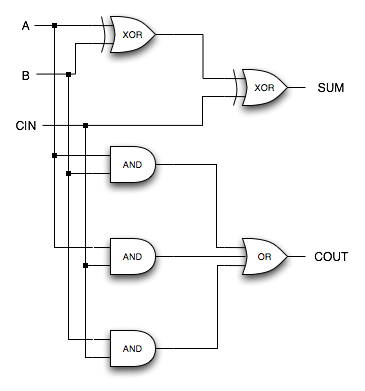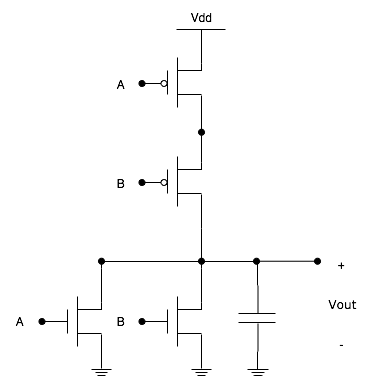Understanding the Cell Microprocessor
by Anand Lal Shimpi on March 17, 2005 12:05 AM EST- Posted in
- CPUs
Understanding Gates
The fundamental building blocks of any microprocessor are gates. Gates are collections of transistors that electrically mimic a particular logic function. For example, a 2-input AND gate will take two input signals and output a 1 only if the two inputs are both 1s. An XOR gate will output a 1 only if the two inputs are different. A NOR gate will output a 1 only if all inputs are 0s.Combinations of these gates are used to implement everything in a microprocessor, including functional units like adders, multipliers, etc.

Here, we have a 1-bit carry adder implemented using logic gates. It will add any two 1-bit numbers and produce a result.
A very popular way of designing gate logic is using what is known as static CMOS. Static CMOS designs are relatively easy to implement and there are tons of libraries available for automated (e.g. computer driven) static CMOS design. There are a couple of problems with static CMOS design:
- Static CMOS circuits aren’t the fastest circuits possible, which is why they aren’t used in things like Intel’s double-pumped ALUs where high clock speeds are necessary.
- Static CMOS designs use quite a few transistors. For each m-input gate, you need 2 * m transistors (m PMOS and m NMOS transistors), which for high fan-in gates (gates with lots of inputs), it drives transistor counts up considerably. As is the case with any heavily SIMD architecture, high fan-in gates are commonplace.

There’s another problem here - the NOR gate isn’t clocked. Normally, large collections of gates are assembled and put behind an element called a latch, which is clocked. One type of large collection would be all of the circuitry used for a pipeline stage. This isn’t really a problem for static CMOS gates, as it greatly simplifies the distribution of clocks to the chip (since you don’t have to route a clock signal to every gate, just every latch, and there are far more general gates than there are latches).
Designing and implementing static CMOS gates are extremely easy. Hardware Description Languages (HDLs), programming languages in which chips are “written” have widespread static CMOS libraries, meaning that a chip designer can focus on writing code to crank out a chip without having to hand design its circuits. But as success is usually proportional to difficulty, static CMOS designs aren’t the fastest things in the world. Things like Intel’s 7.2GHz ALUs aren’t designed using static CMOS logic, neither is Cell.










70 Comments
View All Comments
ceefka - Thursday, March 17, 2005 - link
Rambus'RevengeLocut0s - Thursday, March 17, 2005 - link
Great article Anand!! Yeah I actually get to bring my Comp150 knowledge to bear in reading this article! If this had come out 6 months ago I would have been totally lost. It will indeed be interesting to see what headway Cell can make, however unfortunately as Anand alludes to the x86 architecture is just too heavily entrenched for anything to budge it except the Big 2 (AMD and Intel). I can't wait to see what type of power the Playstation 3 will have though, and especially how that power will be utilized in games. I bet there will be some jaw dropping graphics awaiting us there. That is if Cells limitations don't hold back lazy game developers and lead to a string of mediocre games punctuated by a few amazing titles made by independent developers who really care to utilize the architecture. Didn't the Playstantion 1 suffer something similar?knitecrow - Thursday, March 17, 2005 - link
The real world technology article on the cell, states that it gives up single thread performance in favour of runing many parallel threads. That sounds like a terrible difficult processor to development games for.I for one think it will be easier to put the burden on the hardware rather than on the software side.
Can we see another repeat of PS2? Technically impressive, but hard to code for.
JarredWalton - Thursday, March 17, 2005 - link
11 - I think the point is that games tend to use certain functions of a CPU much more frequently, while general business/office applications make use of a wider range of generic operations. I understand your complaint, as office applications generally don't need a lot more power than about 1.5 GHz at most. However, the key of the statement was the "general purpose microprocessor" and not the "very powerful" part.AnandThenMan - Thursday, March 17, 2005 - link
WAIT. What the flock does this mean?"Performance in business/office applications requires a very powerful, very fast general purpose microprocessor, but performance in a game console, for example, does not."
WHAT??????? Hello?? So an office app like Word needs a very powerful processor, but a game console does not? I beg to differ. I suppose it depends on how you define "business/office application" but I think that statement is WAY off. I know several current office applications that will limp along on a pentium 133, but no current game has any hope on the same CPU.
tipoo - Wednesday, July 30, 2014 - link
It was clear to me that meant console CPUs didn't have to be as general purpose and brute force powerful in every regard - they can get away with being more specialized, and suck at general work, but still fast for game specific code.Googer - Thursday, March 17, 2005 - link
When are they coming out? Anyone know of a release date?jeffbui - Thursday, March 17, 2005 - link
#4, I do. Heh.I've been waiting for this article forever.. thanks!
JarredWalton - Thursday, March 17, 2005 - link
Interesting stuff. The Playstation has always been something of a pain in the rear to program. PS1 went it's own way, and PS2 did the same. PS3 and Cell seem ready to pave new roads into the "OMG this is really complex" land of programming. I'm glad I've given up serious programming.... :)Googer - Thursday, March 17, 2005 - link
In soviet russia cell processor controls your mind.